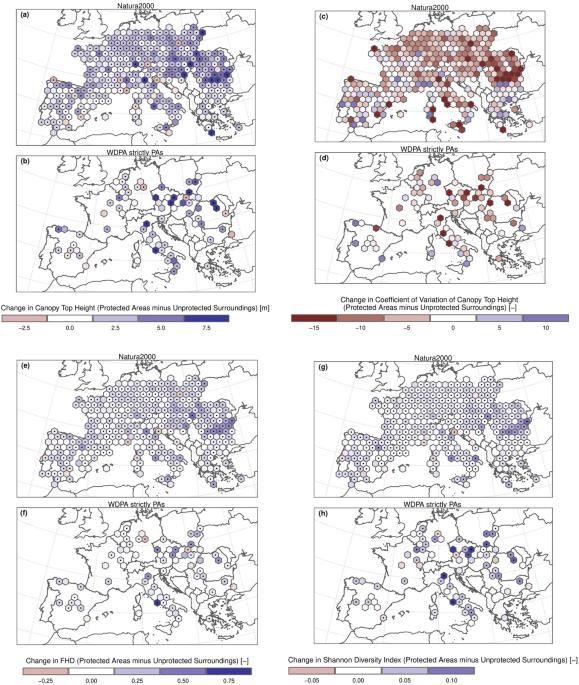Spaceborne LiDAR reveals the effectiveness of European Protected Areas in conserving forest height and vertical structure
IF 8.9
1区 地球科学
Q1 ENVIRONMENTAL SCIENCES
引用次数: 2
Abstract
The effectiveness of Protected Areas in conserving forest ecosystems has been examined at the continental scale using area-based habitat parameters, but knowledge of the three-dimensional structure of forest habitats is still lacking. Here, we assess the effectiveness of European Protected Areas in conserving the vertical structure of forests by analysing more than 30 million records from the Global Ecosystem Dynamics Investigation (GEDI), a spaceborne LiDAR (Light Detection And Ranging) mission. We compare a suite of indicators of the vertical structure of forests inside and outside nearly 10,000 protected areas. We find that European forests are on average 2 m taller and vertically more complex in protected areas than in nearby unprotected areas, albeit with some regional differences. At the same time, forests outside protected areas show greater variations in canopy height than inside, probably as a result of past and current forest management operations. Our findings highlight the positive imprint of environmental policies on forest structure across Europe and underscore how spaceborne LiDAR enables the large-scale monitoring of forest vertical structural attributes that are key to conservation and restoration policies. Protected areas are effective in preserving the height and vertical structure of European forests, according to an analysis of spaceborne data from the Global Ecosystem Dynamics Investigation.

星载激光雷达揭示了欧洲保护区在保护森林高度和垂直结构方面的有效性
保护区在保护森林生态系统方面的有效性已在大陆范围内使用基于面积的生境参数进行了研究,但对森林生境的三维结构仍然缺乏了解。在这里,我们通过分析来自全球生态系统动态调查(GEDI)的 3,000 多万条记录,评估了欧洲保护区在保护森林垂直结构方面的有效性,GEDI 是一项空间激光雷达(LiDAR)任务。我们比较了近 10,000 个保护区内外森林垂直结构的一系列指标。我们发现,与附近的非保护区相比,欧洲保护区内的森林平均高出 2 米,垂直结构更加复杂,尽管存在一些地区差异。同时,与保护区内相比,保护区外的森林树冠高度变化更大,这可能是过去和现在森林管理运作的结果。我们的研究结果凸显了环境政策对整个欧洲森林结构的积极影响,并强调了空间激光雷达如何实现对森林垂直结构属性的大规模监测,而这正是保护和恢复政策的关键所在。根据对全球生态系统动态调查(Global Ecosystem Dynamics Investigation)空间数据的分析,保护区能有效保护欧洲森林的高度和垂直结构。
本文章由计算机程序翻译,如有差异,请以英文原文为准。
求助全文
约1分钟内获得全文
求助全文
来源期刊

Communications Earth & Environment
Earth and Planetary Sciences-General Earth and Planetary Sciences
CiteScore
8.60
自引率
2.50%
发文量
269
审稿时长
26 weeks
期刊介绍:
Communications Earth & Environment is an open access journal from Nature Portfolio publishing high-quality research, reviews and commentary in all areas of the Earth, environmental and planetary sciences. Research papers published by the journal represent significant advances that bring new insight to a specialized area in Earth science, planetary science or environmental science.
Communications Earth & Environment has a 2-year impact factor of 7.9 (2022 Journal Citation Reports®). Articles published in the journal in 2022 were downloaded 1,412,858 times. Median time from submission to the first editorial decision is 8 days.
 求助内容:
求助内容: 应助结果提醒方式:
应助结果提醒方式:


